Bioprinted muscle cell regeneration accelerated by integrating neural cells

Researchers from the Wake Forest Institute for Regenerative Medicine (NC, USA) have developed a tissue engineering technique for skeletal muscles which better integrates neural cells into into the bioprinted tissues.
Researchers from Wake Forest’s Institute for Regenerative Medicine (WFIRM; NC, USA) have reportedly achieved improved neural cells integration into bioengineered skeletal muscle tissue, utilizing 3D bioprinting technologies.
Traditional approaches to treating extensive muscle defects often fall short and can result in an inability for the nerve to properly integrate into the muscular tissue. These methods, utilizing reconstructive surgery and muscle grafts, can result in lack of mobility and control.
This combined bioprinting approach could be a crucial step towards the possibility of using bioengineered skeletal muscle tissues for treating patients. This technology could be particular useful in the treatment of soldiers following severe injuries from IEDs during active duty.
“Being able to bioengineer implantable skeletal muscle constructs that mimics the native muscle to restore function represents a significant advance in treating these types of injuries,” explained Ji Hyun Kim (WFIRM). “Our hope is to develop a therapeutic option that will help heal injured patients and give them back as much function and normalcy as possible.”
Previously, the team demonstrated that their Integrated Tissue and Organ Printing System (ITOP) was capable of generating 3D-printed muscle tissue, which were well organized and robust enough to maintain its structure.
In other recent work, the team have furthered their work and tested different combinations of cells and different types of skeletal muscle tissue constructs in an attempt to produce functional muscle tissue.
Published in Nature Communications, the team have now investigated the integration of neural cells into bioprinted skeletal muscle tissue in order to accelerate functional muscle regeneration.
“These constructs were able to facilitate rapid nerve distribution and matured into organized muscle tissue that restored normal muscle weight and function in a pre-clinical model of muscle defect injury,” added Sang Jin Lee (WFIRM).
Sources: Kim JH, Kim I, Seol YJ et al. Neural cell integration into 3D bioprinted skeletal muscle constructs accelerates restoration of muscle function. Nat. Comms. 11, 1025 (2020); https://newsroom.wakehealth.edu/News-Releases/2020/02/Neural-Cells-Speed-up-Function-in-3D-Bioprinted-Skeletal-Muscle-Constructs
Read more on 3D printing at our sister site, 3DMedNet>>>
Have any additional questions about this story? Ask us in the comments, below.
Find out more in these top picks from the Editor:
- 3D printing nerves: an interview with Kobi Koffler
- 3D printed implants could restore neural pathways in spinal cord injury
- Organ tissue 3D printed from bioactive glass and stem cells — 3DMedNet